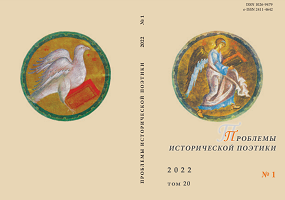Концептъ любви и формы его воплощенія въ романѣ Ѳ. М. Достоевскаго «Идіотъ»
The Concept of Love and the Forms of Its Embodiment in the Novel by F. M. Dostoevsky “The Idiot”
Author(s): Artyom A. SkulkinSubject(s): Christian Theology and Religion, Philosophy, Russian Literature
Published by: Петрозаводский государственный университет
Keywords: F. M. Dostoevsky; “The Idiot”; V. S. Solovyov; love; descending; ascending; balanced; traditional orthography;
Summary/Abstract: In the article, the concept of love, embodied in F. M. Dostoevsky’s novel “The Idiot,” is considered from the point of view of three religious and philosophical types of love identified by V. S. Solovyov, namely, ascending love (amor ascendens), descending love (amor descendens) and balanced love (amor aequalis). This approach allows not only to conceptualize the forms of manifestation of love in “The Idiot” in the context of V. S. Solovyov’s thoughts, but also to identify the readers’ tradition of adequate perception of Dostoevsky’s work, associated with the mental and spiritual atmosphere of the era. Seeing the meanings of the novel through the “eyes” of V. S. Solovyov allows to outline the national value code of reading. Each type of love designated by the philosopher in Dostoevsky’s novel corresponds to descending love (amor descendens), embodied in parental love (Lizaveta Prokofievna and Ardalion Alexandrovich), sacrificial love (Nastasya Filippovna Barashkina) and Christian love (Lev Nikolaevich Myshkin). The manifestations of selfless children’s love (Swiss children) and passionate love (Parfyon Rogozhin) became forms of embodiment of ascending love (amor ascendens). The forms of embodiment of balanced love (amor aequalis) include “brotherly” love (Epanchiny sisters: Aglaya, Adelaide, Anastasia). However, the love of God is the highest form of love in hierarchy (which includes all others), the effective power of which begins with faith: therefore, it is no coincidence that the episode with the painting by Hans Holbein the Younger “Dead Christ in the Tomb” becomes the meaning-generating theoanthropic center of “The Idiot.”
Journal: Проблемы исторической поэтики
- Issue Year: 20/2022
- Issue No: 1
- Page Range: 187-207
- Page Count: 21
- Language: Russian

